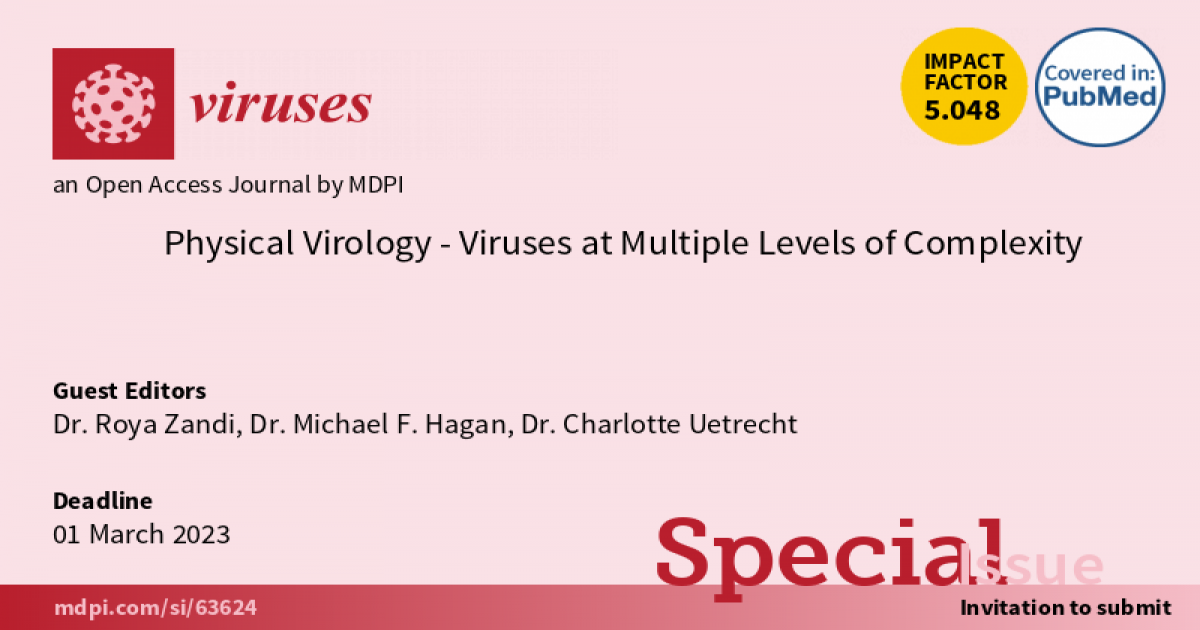Physical Virology - Viruses at Multiple Levels of Complexity
A special issue of Viruses (ISSN 1999-4915). This special issue belongs to the section "General Virology".
Deadline for manuscript submissions: closed (10 July 2023) | Viewed by 31964

Special Issue Editors
Interests: statistical mechanics and condensed matter physics of virus assembly
Interests: physical principles controlling control assembly and dynamical organization of viruses
Interests: norovirus assembly and entry; coronaviral replication/transcription complexes; structural mass spectrometry; single particle imaging with X-ray free-electron lasers
Special Issue Information
Dear Colleagues,
Viral infections involve processes from atomic-scale regulation of ionic transport, to macromolecular self-assembly and membrane budding, to global epidemiology. Physical virology studies these processes as a paradigm for the intersection of fundamental physical laws and emergent biological function. Thus, diverse disciplines are relevant to physical virology, and the field is unique for its simultaneous focus on fundamental and applied aspects of virology. This Special Issue will present works by researchers with scientific expertise in virology, chemistry, material science, mathematics, physics, and engineering who share a common desire to (1) understand the biophysical mechanisms that enable and regulate viral lifecycles, (2) use this knowledge to develop and engineer novel nanotechnology platforms based on viral particles or other self-assembling structures, with applications including biomimetic materials and optoelectronics, and (3) broaden physical virology to leverage recent advances in cell biology and protein design. The COVID-19 pandemic has highlighted the need for these cross-disciplinary approaches to understand viral biology, predict their global spread and impact, and generate the fundamental knowledge that provides the foundation for the development of new treatments.
Dr. Roya Zandi
Dr. Michael F. Hagan
Dr. Charlotte Uetrecht
Guest Editors
Manuscript Submission Information
Manuscripts should be submitted online at www.mdpi.com by registering and logging in to this website. Once you are registered, click here to go to the submission form. Manuscripts can be submitted until the deadline. All submissions that pass pre-check are peer-reviewed. Accepted papers will be published continuously in the journal (as soon as accepted) and will be listed together on the special issue website. Research articles, review articles as well as short communications are invited. For planned papers, a title and short abstract (about 100 words) can be sent to the Editorial Office for announcement on this website.
Submitted manuscripts should not have been published previously, nor be under consideration for publication elsewhere (except conference proceedings papers). All manuscripts are thoroughly refereed through a single-blind peer-review process. A guide for authors and other relevant information for submission of manuscripts is available on the Instructions for Authors page. Viruses is an international peer-reviewed open access monthly journal published by MDPI.
Please visit the Instructions for Authors page before submitting a manuscript. The Article Processing Charge (APC) for publication in this open access journal is 2600 CHF (Swiss Francs). Submitted papers should be well formatted and use good English. Authors may use MDPI's English editing service prior to publication or during author revisions.
Keywords
- virus assembly and disassembly
- virus dynamics and mechanics
- symmetry
- biomaterials and virus-inspired designs
- cargo encapsidation and release
- membraneous compartments
- interaction networks
- immunity
- evolution and vaccines
Benefits of Publishing in a Special Issue
- Ease of navigation: Grouping papers by topic helps scholars navigate broad scope journals more efficiently.
- Greater discoverability: Special Issues support the reach and impact of scientific research. Articles in Special Issues are more discoverable and cited more frequently.
- Expansion of research network: Special Issues facilitate connections among authors, fostering scientific collaborations.
- External promotion: Articles in Special Issues are often promoted through the journal's social media, increasing their visibility.
- e-Book format: Special Issues with more than 10 articles can be published as dedicated e-books, ensuring wide and rapid dissemination.
Further information on MDPI's Special Issue polices can be found here.






